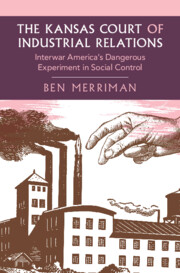Refine search
Actions for selected content:
50 results
Need-Based Aid, Racial Proportionality, and the College Work-Study Program of the National Youth Administration, 1934-1943
-
- Journal:
- History of Education Quarterly , First View
- Published online by Cambridge University Press:
- 16 September 2025, pp. 1-20
-
- Article
- Export citation
2 - Discovering Housing-Based Growth in America
-
- Book:
- Through the Roof
- Published online:
- 28 August 2025
- Print publication:
- 11 September 2025, pp 28-67
-
- Chapter
- Export citation
8 - Locking into Liberalism
- from Part II - The KCIR in the World
-
- Book:
- The Kansas Court of Industrial Relations
- Published online:
- 26 July 2025
- Print publication:
- 14 August 2025, pp 197-217
-
- Chapter
- Export citation
1 - The Court That Failed
-
- Book:
- The Kansas Court of Industrial Relations
- Published online:
- 26 July 2025
- Print publication:
- 14 August 2025, pp 1-32
-
- Chapter
-
- You have access
- HTML
- Export citation

The Kansas Court of Industrial Relations
- Interwar America's Dangerous Experiment in Social Control
-
- Published online:
- 26 July 2025
- Print publication:
- 14 August 2025
Introduction
-
- Book:
- The Age of Youth
- Published online:
- 27 May 2025
- Print publication:
- 24 April 2025, pp 1-25
-
- Chapter
- Export citation
11 - The Little Fellow and the Great Depression
-
- Book:
- Citizen Cowboy
- Published online:
- 16 August 2024
- Print publication:
- 29 August 2024, pp 284-316
-
- Chapter
- Export citation
A New Deal for Wine
-
- Journal:
- Journal of Policy History / Volume 36 / Issue 3 / July 2024
- Published online by Cambridge University Press:
- 27 August 2024, pp. 260-280
-
- Article
-
- You have access
- Open access
- HTML
- Export citation
Risking Reform
-
- Journal:
- Church History / Volume 93 / Issue 2 / June 2024
- Published online by Cambridge University Press:
- 17 June 2025, pp. 263-271
- Print publication:
- June 2024
-
- Article
-
- You have access
- Open access
- HTML
- Export citation
5 - Franklin Delano Roosevelt’s America
-
- Book:
- How Government Built America
- Published online:
- 08 May 2024
- Print publication:
- 09 May 2024, pp 51-65
-
- Chapter
- Export citation
24 - Conservatism and the Essay
- from Part III - Postwar Essays and Essayism (1945–2000)
-
-
- Book:
- The Cambridge History of the American Essay
- Published online:
- 28 March 2024
- Print publication:
- 14 December 2023, pp 410-424
-
- Chapter
- Export citation
Oscar DePriest and Black Agency in American Politics, 1928–1934
-
- Journal:
- Journal of Policy History / Volume 36 / Issue 1 / January 2024
- Published online by Cambridge University Press:
- 14 December 2023, pp. 134-160
-
- Article
- Export citation
5 - Angels of the State
- from Part II - Managing the Global Economy, c.1945–1975
-
- Book:
- Virtue Capitalists
- Published online:
- 07 September 2023
- Print publication:
- 21 September 2023, pp 137-168
-
- Chapter
- Export citation
10 - Modern Folk, Modernist Documentary
- from Part II - Forms, Genre, and Media
-
-
- Book:
- The Cambridge History of American Modernism
- Published online:
- 13 July 2023
- Print publication:
- 20 July 2023, pp 189-206
-
- Chapter
- Export citation
Gender and Disability in US State Temporary Disability Systems 1942–1949
-
- Journal:
- Journal of Policy History / Volume 35 / Issue 3 / July 2023
- Published online by Cambridge University Press:
- 07 July 2023, pp. 309-332
-
- Article
- Export citation
6 - The Death of Laissez-Faire and the Rise of Infrastructure in the Cold War
-
- Book:
- Privatization and Its Discontents
- Published online:
- 08 June 2023
- Print publication:
- 22 June 2023, pp 169-198
-
- Chapter
- Export citation
Whose Work Counts? Congressional Republicans and the Battle over Employment Status, 1947–48
-
- Journal:
- Studies in American Political Development / Volume 37 / Issue 2 / October 2023
- Published online by Cambridge University Press:
- 09 March 2023, pp. 164-180
-
- Article
-
- You have access
- Open access
- HTML
- Export citation
Chapter 15 - To Thee We Sing
-
- Book:
- American Song and Struggle from Columbus to World War 2
- Published online:
- 30 July 2022
- Print publication:
- 18 August 2022, pp 333-365
-
- Chapter
- Export citation
21 - Who Wrote the Best Closing Line of Modern Literature?
-
- Book:
- Our Long Walk to Economic Freedom
- Published online:
- 30 August 2022
- Print publication:
- 04 August 2022, pp 121-126
-
- Chapter
- Export citation
From Labor Rights to the Right to Work: Constituting and Resisting Social Citizenship, 1932–1953
-
- Journal:
- Journal of Policy History / Volume 34 / Issue 3 / July 2022
- Published online by Cambridge University Press:
- 06 June 2022, pp. 371-402
-
- Article
- Export citation
